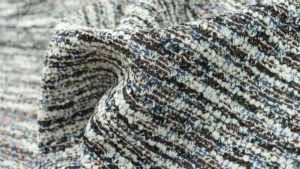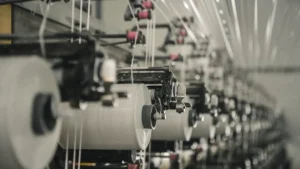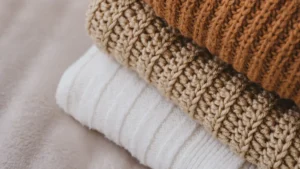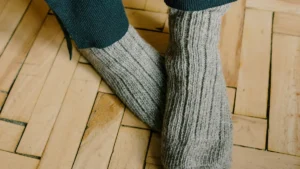
Choosing the right sock yarn is crucial when you want to knit mittens with sock yarn. You desire mittens that are warm, maintain their shape, and have longevity. Sock yarn is an excellent choice because it’s strong, stretchy, and typically made of wool. Wool not only keeps your hands warm but also wicks away moisture. When you knit mittens with sock yarn, they fit snugly and feel comfortable. Understanding these yarn characteristics aids you in selecting the best material. This ensures that your mittens will not only look great but also perform effectively.
Key Takeaways
Pick sock yarn with wool to keep hands warm and dry. Wool helps in cold weather by wicking away moisture.
Choose sock yarn with nylon for strength and stretch. Nylon makes mittens last longer and fit better.
Knit small test pieces to try out different yarns. This shows how the yarn feels and works before you begin.
Think about the weather and how you’ll use the mittens. Wool is best for cold places, while lighter yarns suit warmer areas.
Save money by shopping sales, buying in bulk, or using second-hand yarn. Good sock yarn doesn’t have to cost a lot.
What Makes Sock Yarn Great for Mittens?
Why sock yarn works well for mittens
Sock yarn has special traits that make it great for mittens. It’s tough, stretchy, and strong, so your mittens last longer. The yarn’s tight twist adds strength, perfect for areas like palms and fingertips. Worsted spinning makes the yarn smooth, showing off neat stitches and patterns. Sock yarn often uses long fibers, which stop it from breaking and keep mittens looking nice for years.
Here’s a simple list of sock yarn’s best features:
Feature | What It Does |
|---|---|
Toughness | Handles wear and keeps mittens in good shape. |
Strength | Stops damage, making mittens last longer. |
Stretchiness | Helps mittens fit snugly and stay comfy. |
Smooth texture | Makes stitches clear and patterns stand out. |
Tight twist | Adds strength for areas that get lots of use. |
Long fibers | Prevents breaks, keeping mittens durable. |
These qualities make mittens warm, useful, and stylish.
Materials in sock yarn and their perks
Sock yarn blends wool with other fibers to improve its use. Wool is the main fiber, giving warmth and pulling moisture away to keep hands dry. Nylon is added for extra strength and stretch, so mittens stay comfy and keep their shape. Some sock yarns mix in bamboo or alpaca for softness and luxury.
Here’s what each fiber adds:
Wool: Warm, breathable, and keeps hands dry.
Nylon: Makes mittens stronger and more flexible.
Bamboo: Soft and eco-friendly.
Alpaca: Warm, light, and fancy.
Sock yarn combines fibers to make mittens that are both useful and pretty.
Why knitters love sock yarn for mittens
Sock yarn is a favorite choice for mittens because it’s versatile and strong. Knitters enjoy its durability and the many colors and textures it offers. Ashley N., an experienced knitter, likes how sock yarn fits different projects. Mel S. appreciates its lasting quality, while Liz S. loves the variety in weight and color for any mitten design.
If you’re new to sock yarn, you’ll quickly see why it’s loved. It’s not just practical—it’s fun to work with. Whether you want bright colors or soft tones, sock yarn has options for everyone.
Comparing Sock Yarn Types for Mittens
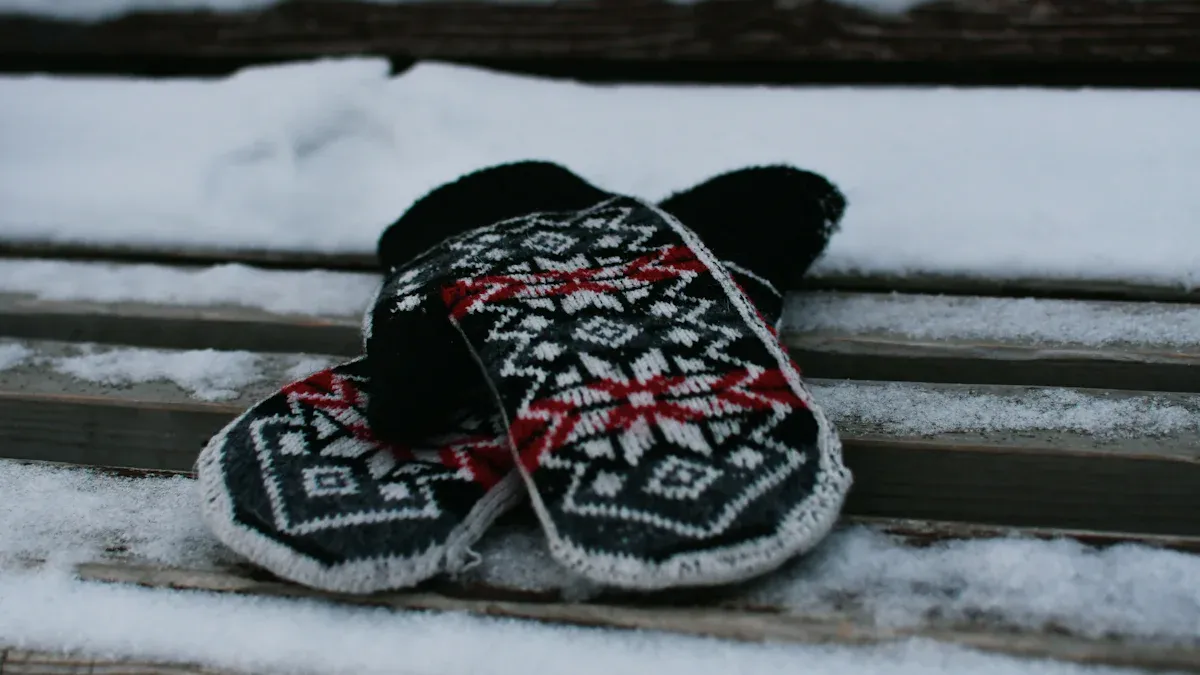
Wool-based sock yarn: Warmth and moisture-wicking
When it comes to knitting mittens, wool-based sock yarn is a top contender. Wool is famous for its ability to keep you warm, even in the coldest weather. It’s not just about warmth, though. Wool also wicks moisture away from your skin, keeping your hands dry and comfortable. This makes it perfect for mittens, especially if you live in a place with damp or snowy winters.
Here’s why wool stands out:
Wool fibers trap heat, keeping your hands cozy in chilly weather.
Even when wet, wool retains warmth, which is a lifesaver in damp conditions.
It regulates temperature, so your mittens feel just right—not too hot, not too cold.
If you’re worried about durability, don’t be. Many wool-based sock yarns include nylon for added strength. This blend ensures your mittens last longer while still offering the warmth and moisture control you need. Whether you’re shoveling snow or enjoying a winter walk, mittens made with wool-based sock yarn will keep your hands happy.
Nylon-blend sock yarn: Durability and elasticity
If you want mittens that can handle daily wear and tear, nylon-blend sock yarn is your go-to choice. Nylon adds durability and elasticity to the yarn, making it perfect for mittens that need to stretch and bounce back into shape. This is especially important for areas like the cuffs and fingers, which see the most movement.
Why choose nylon blends?
They’re tough, so your mittens won’t wear out quickly.
The added stretch ensures a snug, comfortable fit.
They maintain their shape, even after repeated use.
Nylon-blend sock yarn is also great for intricate patterns. The elasticity helps your stitches stay neat and defined, making your mitten designs pop. Plus, these blends often come in a variety of colors and textures, so you can find the perfect match for your style.
Superwash vs. non-superwash sock yarn
When choosing sock yarn for mittens, you’ll often come across two types: superwash and non-superwash. Both have their pros and cons, so it’s all about what works best for you.
Superwash sock yarn is treated to make it machine washable. This is a huge plus if you want mittens that are easy to care for. You can toss them in the washer without worrying about shrinkage. However, superwash yarns can sometimes feel less warm because the treatment alters the wool’s natural structure.
Non-superwash sock yarn, on the other hand, retains all the natural properties of wool. It’s warmer and has better moisture-wicking abilities. The downside? It requires more care. You’ll need to hand wash your mittens and dry them flat to avoid felting.
Here’s a quick comparison:
Type of Yarn | Pros | Cons |
|---|---|---|
Superwash | Easy to care for, machine washable | Slightly less warm, may feel smoother |
Non-superwash | Warmer, better moisture-wicking | Requires hand washing, prone to felting |
If you’re knitting mittens for everyday use, superwash might be the way to go. For special mittens that need extra warmth, non-superwash is worth the extra effort.
Alternative fibers: Bamboo, alpaca, and more
When you hear “sock yarn,” wool is likely your first thought. But other fibers like bamboo and alpaca offer special features. These fibers can make mittens softer, fancier, and even eco-friendly. Let’s see what makes them unique and how they work for mittens.
Bamboo: Smooth and eco-friendly
Bamboo yarn feels soft and silky, making it fun to use. If you want mittens that feel gentle, bamboo is a great pick. It’s also good for the planet since bamboo grows fast and needs fewer resources.
Still, bamboo has downsides. It doesn’t keep heat well, so it’s not ideal for cold weather. Bamboo works better for light mittens or ones for warmer places. For warmth, mix bamboo with wool yarn to get both softness and heat.
Tip: Use bamboo yarn for stylish mittens or layering, not heavy winter mittens.
Alpaca: Cozy and fancy
Alpaca yarn is loved for being warm and soft. It’s lighter than wool but still keeps hands cozy. If you want mittens that feel special, alpaca is a top choice.
But alpaca has a quirk. When squished, it loses some warmth. Let it stay fluffy for the best results. This makes alpaca great for loose mittens or textured designs that don’t press the fiber down.
Here’s a quick look at bamboo vs. alpaca:
Fiber | Pros | Cons |
|---|---|---|
Bamboo | Soft, silky, eco-friendly | |
Alpaca | Warm, light, luxurious | Loses warmth when flattened |
Other fibers to try
Besides bamboo and alpaca, fibers like silk, cashmere, and cotton have perks too. Silk adds shine and strength, cashmere is super soft, and cotton is breathable. These fibers are less common in sock yarn but can be mixed with wool for stylish, useful mittens.
Note: Always check the yarn label to match your mitten needs. Blends combine the best traits of different fibers.
Trying alternative fibers can make your mittens unique. Whether you want softness, warmth, or eco-friendliness, there’s a fiber for you. Experimenting with these options can create mittens that stand out.
Key Factors to Think About When Knitting Mittens with Sock Yarn
Texture: Softness and clear stitches
The texture of sock yarn affects how mittens feel and look. You want mittens that are soft on your skin and show off your stitches clearly. Sock yarn often has a smooth surface, making it great for neat patterns. Whether you knit cables, lace, or plain designs, the texture helps your work stand out.
For cozy mittens, choose sock yarn made with wool. Wool feels warm and natural, perfect for comfort. If you want extra softness, try blends with alpaca or bamboo. These fibers make mittens feel fancy but still keep the stitches clear.
Tip: Knit a small test piece before starting. This shows how the yarn feels and how well it highlights your pattern.
Elasticity: A snug and comfy fit
Stretchy yarn is important for mittens that fit well and feel good. Sock yarn stretches naturally, so mittens hug your hands without being tight. This is especially useful for cuffs and fingers, which need to move easily.
To get the best fit, remember these tips:
Ribbing: Add ribbing to cuffs for stretch and a snug fit.
Needle Size: Use smaller needles for tighter, more elastic stitches.
Cast-On: Start with a loose cast-on to avoid tight wrists.
Here’s a quick guide for elasticity:
Key Aspect | Recommendation |
|---|---|
Ribbing | Adds stretch and keeps mittens snug. |
Needle Size | Smaller needles improve elasticity. |
Cast-On Technique | A loose cast-on ensures a comfy wrist fit. |
Follow these steps to make mittens that stretch easily but keep their shape.
Weight: Warmth and usefulness
The weight of sock yarn decides how warm and practical your mittens are. Thicker yarns, like DK or worsted weight, are warmer and great for cold weather. Thinner yarns, like fingering weight, work better for mild winters or layering under gloves.
Wool-based sock yarn is a smart choice for warmth and breathability. It keeps your hands cozy without making them too hot. For outdoor mittens, pick yarn blends with nylon. Nylon makes mittens stronger without adding bulk.
Note: Think about your weather and daily needs when picking yarn weight. Medium-weight sock yarn is a good choice for most uses.
By focusing on texture, stretch, and weight, you can make mittens that are both pretty and useful. Sock yarn lets you adjust your project for warmth, style, or both.
Durability: Ensuring long-lasting mittens
When you knit mittens with sock yarn, durability becomes a key factor. You want mittens that can handle daily wear and still look great after months—or even years—of use. The good news? Sock yarn is designed with durability in mind, making it an excellent choice for creating mittens that stand the test of time.
Why durability matters
Mittens go through a lot. From gripping icy railings to stuffing hands into coat pockets, they face constant friction and stretching. Without durable yarn, your mittens might lose their shape, develop holes, or wear out quickly. Choosing the right materials and techniques ensures your hard work pays off with mittens that last.
How to ensure durability in your mittens
Here are some practical tips to make your mittens more durable:
Choose yarn with nylon content
Sock yarns often include nylon, which adds strength and elasticity. This blend helps your mittens resist wear and tear, especially in high-stress areas like the fingertips and palms. Look for yarns with at least 20% nylon for the best results.Opt for tightly spun yarn
Tightly spun yarn has a smoother surface, which reduces pilling and makes the mittens sturdier. It also enhances stitch definition, so your patterns stay crisp and clear over time.Reinforce high-wear areas
Add extra durability to spots that see the most friction. For example, you can double up the yarn when knitting the fingertips or use a reinforcing thread. This small step can significantly extend the life of your mittens.Stick with wool-based yarns
Wool is naturally strong and resilient. It can stretch without breaking and bounce back to its original shape. Plus, wool fibers are less likely to fray, making them ideal for mittens that need to endure frequent use.
Tip: If you’re making mittens for kids or outdoor activities, prioritize durability over softness. A sturdy pair of mittens will hold up better against rough play or harsh weather.
Testing your yarn for durability
Before you start knitting, it’s a good idea to test your yarn. Knit a small swatch and rub it between your fingers or against a rough surface. Does it pill or fray easily? If so, consider switching to a more durable option. This simple test can save you time and frustration later.
Balancing durability with comfort
While durability is important, you don’t want mittens that feel stiff or scratchy. Wool-based sock yarn strikes a great balance. It’s tough enough to last but still soft and cozy on your hands. If you’re looking for extra comfort, try blends that include alpaca or bamboo. These fibers add a touch of luxury without compromising strength.
By focusing on durability, you’ll create mittens that not only look beautiful but also stand up to everyday challenges. Whether you’re braving a snowy winter or just running errands, your mittens will keep your hands warm and protected for seasons to come.
Practical Tips for Choosing the Best Sock Yarn
Matching yarn to your mitten pattern
Your mitten pattern plays a big role in choosing the right sock yarn. Patterns often suggest a specific yarn weight, like fingering or DK, to achieve the correct size and texture. Following this recommendation ensures your mittens turn out as expected.
If your pattern includes intricate designs like cables or lace, go for a smooth sock yarn. This type of yarn highlights the details and makes your hard work stand out. For simpler patterns, you can experiment with textured or variegated yarns to add visual interest.
Tip: Always check the yardage requirements in your pattern. Running out of yarn mid-project can be frustrating!
Considering climate and intended use
Think about where and how you’ll use your mittens. If you live in a cold, snowy area, wool-based sock yarn is your best friend. Wool traps heat and wicks away moisture, keeping your hands warm and dry. For milder climates, lighter yarns or blends with bamboo might be more comfortable.
Are these mittens for everyday wear or special occasions? For daily use, choose durable yarns with nylon. If they’re for a fancy event, you might prefer luxurious blends with alpaca or silk. Matching the yarn to your needs ensures your mittens are both practical and stylish.
Testing yarn swatches for texture and performance
Before you dive into knitting, take a moment to test your yarn. Knit a small swatch to see how it feels and behaves. Does it stretch enough? Are the stitches clear? Testing helps you avoid surprises later.
Rub the swatch gently to check for pilling. If it frays easily, it might not hold up well for mittens. Also, wash the swatch to see how the yarn reacts. Some yarns shrink or lose their shape after washing, which can affect the final fit of your mittens.
Pro Tip: Testing isn’t just for beginners. Even experienced knitters test swatches to ensure the best results.
By following these tips, you’ll find the perfect sock yarn to knit mittens with sock yarn that are warm, durable, and beautiful.
Budget-friendly options for quality sock yarn
Knitting mittens doesn’t have to break the bank. You can find great sock yarn options that are both affordable and high-quality. Here’s how you can save money while still getting yarn that works perfectly for your mitten projects.
Look for sales and discounts
Yarn shops often run sales, especially during holidays or end-of-season clearances. Keep an eye out for discounts on sock yarn. Many online retailers also offer coupon codes or loyalty programs. Signing up for newsletters can alert you to upcoming deals.
Tip: Check clearance sections in craft stores. You might find hidden gems at a fraction of the price.
Explore budget-friendly brands
Some yarn brands are known for offering quality products at lower prices. Brands like Knit Picks, Lion Brand, and Cascade Yarns have affordable sock yarn options. These brands balance cost and quality, making them ideal for budget-conscious knitters.
Here’s a quick comparison of popular budget-friendly brands:
Brand | Price Range | Features |
|---|---|---|
Knit Picks | $ | Wide color range, soft textures |
Lion Brand | $ | Durable, easy to find in stores |
Cascade Yarns | $ | Great blends, vibrant colors |
Buy in bulk
Buying yarn in larger quantities can save you money. Many retailers offer discounts for bulk purchases. If you’re planning multiple mitten projects, this is a smart way to stock up.
Pro Tip: Share bulk purchases with friends or knitting groups to split costs.
Try second-hand or thrift options
Thrift stores and online marketplaces like eBay or Facebook Marketplace often have yarn at bargain prices. Sometimes, knitters sell unused yarn from their stash, giving you a chance to snag high-quality sock yarn for less.
Don’t overlook acrylic blends
While wool-based sock yarn is popular, acrylic blends can be a cheaper alternative. They’re durable, easy to care for, and come in a variety of colors. Mixing acrylic with wool can give you the best of both worlds—affordability and warmth.
By following these tips, you’ll find sock yarn that fits your budget without sacrificing quality. Happy knitting!
Picking the best sock yarn for mittens is very important. Things like texture, stretchiness, thickness, and strength affect how they turn out. Wool yarn keeps hands cozy, while nylon blends make them stronger. Fibers like bamboo or alpaca add softness or a fancy touch to your mittens.
Tip: Try new yarns! Testing different types helps you find your favorite.
Great mittens come from using good yarn, a smart pattern, and your imagination. Grab your needles, choose your yarn, and create mittens that are both pretty and useful. Have fun knitting!
FAQ
What is the best sock yarn for beginners knitting mittens?
Start with wool-based sock yarn blended with nylon. It’s durable, stretchy, and easy to work with. Look for medium-weight yarns like DK or worsted for easier handling. These options help you focus on learning without worrying about tricky materials.
Can I use leftover sock yarn for mittens?
Absolutely! Mittens are perfect for using up leftover sock yarn. Combine colors for stripes or patterns. Just make sure the yarn weights match to keep the mittens even and comfortable.
How much sock yarn do I need for a pair of mittens?
For adult mittens, you’ll need about 100-150 grams of sock yarn. Smaller sizes, like kids’ mittens, require less—around 50-100 grams. Always check your pattern for exact yardage.
Are mittens made with sock yarn warm enough for winter?
Yes! Wool-based sock yarn traps heat and wicks moisture, keeping your hands warm and dry. For extra warmth, choose thicker yarn or double up the strands. Add a lining for extreme cold.
How do I care for mittens made with sock yarn?
Check the yarn label for care instructions. Superwash yarns are machine washable, while non-superwash yarns need hand washing. Always dry mittens flat to maintain their shape and avoid shrinkage.
Tip: Use a gentle detergent to keep your mittens soft and long-lasting.



